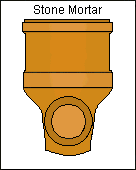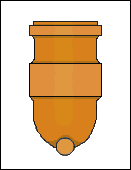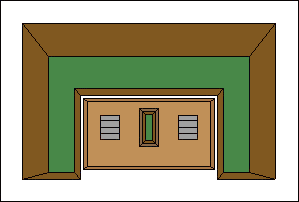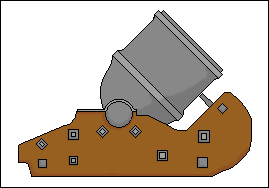Civil War Field Fortifications
Mortar
Batteries
Stone mortars worked on the same principle as the fougass:
high velocity rocks are dangerous to the health and
 well-being
of human bodies. Their sole purpose was to rain a hail of small stones down
on a defending body of troops fighting from behind cover, making it impossible
for the troops to maintain their position at the decisive point, in this
case, the covered way. By the beginning of the Civil War stone mortars had
fallen out of service and had been replaced by small Coehorn Mortars that
could be handled by two or four men. Coehorns were light enough that they
did not require a platform and could be placed at any convenient location
in a trench. Most Coehorns fired 12 or 24 pound shells at ranges from 50
to 1,200 yards. Like stone mortars, they were much too light to be able to
do significant damage to earthworks, rather, the high trajectory of their
shells negated the enemy's cover and could inflict heavy casualties on troops
not protected by bomb or splinter proof shelters.
well-being
of human bodies. Their sole purpose was to rain a hail of small stones down
on a defending body of troops fighting from behind cover, making it impossible
for the troops to maintain their position at the decisive point, in this
case, the covered way. By the beginning of the Civil War stone mortars had
fallen out of service and had been replaced by small Coehorn Mortars that
could be handled by two or four men. Coehorns were light enough that they
did not require a platform and could be placed at any convenient location
in a trench. Most Coehorns fired 12 or 24 pound shells at ranges from 50
to 1,200 yards. Like stone mortars, they were much too light to be able to
do significant damage to earthworks, rather, the high trajectory of their
shells negated the enemy's cover and could inflict heavy casualties on troops
not protected by bomb or splinter proof shelters.
Coehorns were used quite extensively by both sides during
the Siege of Petersburg, Virginia, though the
Confederates never seemed to have enough to go around. During the final bombardment of
Fort Wagner on Morris Island, South Carolina that compelled the Confederates
to evacuate the place the Federal force had a battery of three Coehorns in
their fifth parallel. In the western theater neither side seems to have been
able to find a decent Coehorn when it was really needed. At Vicksburg an
ingenious Federal engineer found a way to shrink iron bands around tree trunks
to make a reasonably effective replacement for Coehorn mortars. When a Federal
mine was exploded under the Third Louisiana Redan on July 1, 1863 the wooden
mortars fired relentlessly into the Confederate reserves who had been called
up to repel the expected attack on the crater (which did not materialize)
causing very heavy casualties. Again at the Siege of Spanish Fort, Alabama
the pioneers of the First Division of the Sixteenth Army Corps fabricated
their own wooden mortars and used them to answer the fire of the Confederates'
nine real Coehorns.
never seemed to have enough to go around. During the final bombardment of
Fort Wagner on Morris Island, South Carolina that compelled the Confederates
to evacuate the place the Federal force had a battery of three Coehorns in
their fifth parallel. In the western theater neither side seems to have been
able to find a decent Coehorn when it was really needed. At Vicksburg an
ingenious Federal engineer found a way to shrink iron bands around tree trunks
to make a reasonably effective replacement for Coehorn mortars. When a Federal
mine was exploded under the Third Louisiana Redan on July 1, 1863 the wooden
mortars fired relentlessly into the Confederate reserves who had been called
up to repel the expected attack on the crater (which did not materialize)
causing very heavy casualties. Again at the Siege of Spanish Fort, Alabama
the pioneers of the First Division of the Sixteenth Army Corps fabricated
their own wooden mortars and used them to answer the fire of the Confederates'
nine real Coehorns.
Larger mortars were another matter entirely. If hauling
around and setting up a Coehorn was easy, the extremely heavy and immobile
siege and sea-coast mortars required extensive preparation, a little heavy
moving equipment, and no small amount of rough cajolery to place in battery
and get them ready to fire. Mortar batteries were usually established in
the  front
or rear of the second parallel and, because mortars didn't generally require
anything else, were almost always sunken and did not have embrasures. The
length of the terre-plein depended on the number of mortars that were to
be placed in the battery; 15 feet was allowed between each mortar, another
six feet for a central traverse, and 10 feet between the mortars on each
flank and the epaulments. The width of the terre-plein ranged from 13 1/2
feet to a maximum of 20 feet. It was sunken to a depth of 3 1/2 feet
from the natural level of the ground in front and 4 feet in the rear to provide
a good slope for drainage. The front slope from ground level to the terre-plein
had a base of two feet and in the rear the slope fell one foot for
every two feet of depth. A one foot wide berme was left between the crest
of the slopes into the terre-plein and the foot of the parapet and epaulments.
The parapet and epaulments ranged from 4 to 4 1/2 feet high and their interior
slopes were not revetted unless the consistency of the soil required it.
Parapets could be between 12 and 18 feet thick, while the thickness of
the
front
or rear of the second parallel and, because mortars didn't generally require
anything else, were almost always sunken and did not have embrasures. The
length of the terre-plein depended on the number of mortars that were to
be placed in the battery; 15 feet was allowed between each mortar, another
six feet for a central traverse, and 10 feet between the mortars on each
flank and the epaulments. The width of the terre-plein ranged from 13 1/2
feet to a maximum of 20 feet. It was sunken to a depth of 3 1/2 feet
from the natural level of the ground in front and 4 feet in the rear to provide
a good slope for drainage. The front slope from ground level to the terre-plein
had a base of two feet and in the rear the slope fell one foot for
every two feet of depth. A one foot wide berme was left between the crest
of the slopes into the terre-plein and the foot of the parapet and epaulments.
The parapet and epaulments ranged from 4 to 4 1/2 feet high and their interior
slopes were not revetted unless the consistency of the soil required it.
Parapets could be between 12 and 18 feet thick, while the thickness of
the epaulments
depended on the type of fire they had to resist. As with gun and howitzer
batteries, the soil to construct the parapet and epaulments was taken from
a shallow ditch excavated around the exterior of the battery.
epaulments
depended on the type of fire they had to resist. As with gun and howitzer
batteries, the soil to construct the parapet and epaulments was taken from
a shallow ditch excavated around the exterior of the battery.
As soon as the terre-plein had been leveled heavy platforms
were laid and positioned so that the mortars' shells would pass at least
three feet above the interior crest of the parapet. A wide variety of mortar
platforms were used during the Civil War, more often than not they had to
be tailored to suit the requirements of specific battery sites. Since mortars
were mounted on beds rather than carriages, solid, level platforms were
absolutely necessary for mortars to be pointed, elevated, and fired accurately.
Smaller heavy mortars, oddly, tended to wear out their platforms rather quickly
while the heaviest, the 13 inch mortars, had beds that were large enough
to spread the shock of the pieces' discharge more evenly over the surface
of their platforms which imparted a longer useful life. Wear could be reduced
by moving mortars around and firing them from different points on their
platforms.
Much of the labor involved in constructing mortar batteries
could be saved by taking advantage of natural depressions or the reverse
side of ridges for battery positions. Since mortars used vertical fire, they
were not aimed in the same way as other types of direct fire pieces and did
not necessarily have to be able to see their targets to fire accurately.
Any convenient ravine with soil capable of supporting a mortar's weight could
be leveled, equppied with platforms, and turned into a battery position with
a natural ready-made parapet.
Heavy mortars could be quite effective at reducing a garrison's
ability to withstand a prolonged siege. At the Siege of Fort Morgan, Alabama
the besieging Federal force used 14 mortars to search the interior spaces
of the fort with their fire. The citadel of the fort, which had not been
demolished as it should have been prior to the siege, was ignited by mortar
fire and the resultant conflagration consumed much of the garrison's food
supply. Mortar fire also induced the commander of the fort to haul 80,000
pounds of powder out of the magazine and have it destroyed by flooding. Since
the garrison was pretty much confined to the shelter of the casemates inside
the fort by the mortar fire, when the Federals' heavy guns started
 breaking into
the casemates the commander felt compelled to surrender before the casemates
were breached to the point of collapse. In other cases mortar fire was not
very effective. At the reduction of Fort Pulaski, near Savannah, Georgia
less than half of the Federal mortar shells landed inside the fort, and the
fire of the heaviest mortars, conducted at ranges beyond 2,000 yards, was
erratic and unrelaible. Brigadier General Qunicy A. Gillmore concluded that
mortars were incapable of breaching casemated sea coast fortifications even
when they could strike the earthwork of the terre-plein on the barbette level
of the walls above the casemates. During the Siege of Vicksburg Federal mortar
fire from the mortar boats of the Mississppi Squadron consistently failed
to hit any significant targets, though they did cause at least one major
fire that consumed several city blocks. Otherwise, their only effect was
to put a bad scare into the civilians unfortunate enough to be trapped in
the besieged city.
breaking into
the casemates the commander felt compelled to surrender before the casemates
were breached to the point of collapse. In other cases mortar fire was not
very effective. At the reduction of Fort Pulaski, near Savannah, Georgia
less than half of the Federal mortar shells landed inside the fort, and the
fire of the heaviest mortars, conducted at ranges beyond 2,000 yards, was
erratic and unrelaible. Brigadier General Qunicy A. Gillmore concluded that
mortars were incapable of breaching casemated sea coast fortifications even
when they could strike the earthwork of the terre-plein on the barbette level
of the walls above the casemates. During the Siege of Vicksburg Federal mortar
fire from the mortar boats of the Mississppi Squadron consistently failed
to hit any significant targets, though they did cause at least one major
fire that consumed several city blocks. Otherwise, their only effect was
to put a bad scare into the civilians unfortunate enough to be trapped in
the besieged city.
Back to Siege Works
Saps
Parallels
Lines of Circumvallation and
Countervallation Trench
Cavalier
Contents Home
Page Major Works
Minor Works
Glossary
Copyright (c) PEM 1998
 well-being
of human bodies. Their sole purpose was to rain a hail of small stones down
on a defending body of troops fighting from behind cover, making it impossible
for the troops to maintain their position at the decisive point, in this
case, the covered way. By the beginning of the Civil War stone mortars had
fallen out of service and had been replaced by small Coehorn Mortars that
could be handled by two or four men. Coehorns were light enough that they
did not require a platform and could be placed at any convenient location
in a trench. Most Coehorns fired 12 or 24 pound shells at ranges from 50
to 1,200 yards. Like stone mortars, they were much too light to be able to
do significant damage to earthworks, rather, the high trajectory of their
shells negated the enemy's cover and could inflict heavy casualties on troops
not protected by bomb or splinter proof shelters.
well-being
of human bodies. Their sole purpose was to rain a hail of small stones down
on a defending body of troops fighting from behind cover, making it impossible
for the troops to maintain their position at the decisive point, in this
case, the covered way. By the beginning of the Civil War stone mortars had
fallen out of service and had been replaced by small Coehorn Mortars that
could be handled by two or four men. Coehorns were light enough that they
did not require a platform and could be placed at any convenient location
in a trench. Most Coehorns fired 12 or 24 pound shells at ranges from 50
to 1,200 yards. Like stone mortars, they were much too light to be able to
do significant damage to earthworks, rather, the high trajectory of their
shells negated the enemy's cover and could inflict heavy casualties on troops
not protected by bomb or splinter proof shelters.
 never seemed to have enough to go around. During the final bombardment of
Fort Wagner on Morris Island, South Carolina that compelled the Confederates
to evacuate the place the Federal force had a battery of three Coehorns in
their fifth parallel. In the western theater neither side seems to have been
able to find a decent Coehorn when it was really needed. At Vicksburg an
ingenious Federal engineer found a way to shrink iron bands around tree trunks
to make a reasonably effective replacement for Coehorn mortars. When a Federal
mine was exploded under the Third Louisiana Redan on July 1, 1863 the wooden
mortars fired relentlessly into the Confederate reserves who had been called
up to repel the expected attack on the crater (which did not materialize)
causing very heavy casualties. Again at the Siege of Spanish Fort, Alabama
the pioneers of the First Division of the Sixteenth Army Corps fabricated
their own wooden mortars and used them to answer the fire of the Confederates'
nine real Coehorns.
never seemed to have enough to go around. During the final bombardment of
Fort Wagner on Morris Island, South Carolina that compelled the Confederates
to evacuate the place the Federal force had a battery of three Coehorns in
their fifth parallel. In the western theater neither side seems to have been
able to find a decent Coehorn when it was really needed. At Vicksburg an
ingenious Federal engineer found a way to shrink iron bands around tree trunks
to make a reasonably effective replacement for Coehorn mortars. When a Federal
mine was exploded under the Third Louisiana Redan on July 1, 1863 the wooden
mortars fired relentlessly into the Confederate reserves who had been called
up to repel the expected attack on the crater (which did not materialize)
causing very heavy casualties. Again at the Siege of Spanish Fort, Alabama
the pioneers of the First Division of the Sixteenth Army Corps fabricated
their own wooden mortars and used them to answer the fire of the Confederates'
nine real Coehorns.
 front
or rear of the second parallel and, because mortars didn't generally require
anything else, were almost always sunken and did not have embrasures. The
length of the terre-plein depended on the number of mortars that were to
be placed in the battery; 15 feet was allowed between each mortar, another
six feet for a central traverse, and 10 feet between the mortars on each
flank and the epaulments. The width of the terre-plein ranged from 13 1/2
feet to a maximum of 20 feet. It was sunken to a depth of 3 1/2 feet
from the natural level of the ground in front and 4 feet in the rear to provide
a good slope for drainage. The front slope from ground level to the terre-plein
had a base of two feet and in the rear the slope fell one foot for
every two feet of depth. A one foot wide berme was left between the crest
of the slopes into the terre-plein and the foot of the parapet and epaulments.
The parapet and epaulments ranged from 4 to 4 1/2 feet high and their interior
slopes were not revetted unless the consistency of the soil required it.
Parapets could be between 12 and 18 feet thick, while the thickness of
the
front
or rear of the second parallel and, because mortars didn't generally require
anything else, were almost always sunken and did not have embrasures. The
length of the terre-plein depended on the number of mortars that were to
be placed in the battery; 15 feet was allowed between each mortar, another
six feet for a central traverse, and 10 feet between the mortars on each
flank and the epaulments. The width of the terre-plein ranged from 13 1/2
feet to a maximum of 20 feet. It was sunken to a depth of 3 1/2 feet
from the natural level of the ground in front and 4 feet in the rear to provide
a good slope for drainage. The front slope from ground level to the terre-plein
had a base of two feet and in the rear the slope fell one foot for
every two feet of depth. A one foot wide berme was left between the crest
of the slopes into the terre-plein and the foot of the parapet and epaulments.
The parapet and epaulments ranged from 4 to 4 1/2 feet high and their interior
slopes were not revetted unless the consistency of the soil required it.
Parapets could be between 12 and 18 feet thick, while the thickness of
the epaulments
depended on the type of fire they had to resist. As with gun and howitzer
batteries, the soil to construct the parapet and epaulments was taken from
a shallow ditch excavated around the exterior of the battery.
epaulments
depended on the type of fire they had to resist. As with gun and howitzer
batteries, the soil to construct the parapet and epaulments was taken from
a shallow ditch excavated around the exterior of the battery.
 breaking into
the casemates the commander felt compelled to surrender before the casemates
were breached to the point of collapse. In other cases mortar fire was not
very effective. At the reduction of Fort Pulaski, near Savannah, Georgia
less than half of the Federal mortar shells landed inside the fort, and the
fire of the heaviest mortars, conducted at ranges beyond 2,000 yards, was
erratic and unrelaible. Brigadier General Qunicy A. Gillmore concluded that
mortars were incapable of breaching casemated sea coast fortifications even
when they could strike the earthwork of the terre-plein on the barbette level
of the walls above the casemates. During the Siege of Vicksburg Federal mortar
fire from the mortar boats of the Mississppi Squadron consistently failed
to hit any significant targets, though they did cause at least one major
fire that consumed several city blocks. Otherwise, their only effect was
to put a bad scare into the civilians unfortunate enough to be trapped in
the besieged city.
breaking into
the casemates the commander felt compelled to surrender before the casemates
were breached to the point of collapse. In other cases mortar fire was not
very effective. At the reduction of Fort Pulaski, near Savannah, Georgia
less than half of the Federal mortar shells landed inside the fort, and the
fire of the heaviest mortars, conducted at ranges beyond 2,000 yards, was
erratic and unrelaible. Brigadier General Qunicy A. Gillmore concluded that
mortars were incapable of breaching casemated sea coast fortifications even
when they could strike the earthwork of the terre-plein on the barbette level
of the walls above the casemates. During the Siege of Vicksburg Federal mortar
fire from the mortar boats of the Mississppi Squadron consistently failed
to hit any significant targets, though they did cause at least one major
fire that consumed several city blocks. Otherwise, their only effect was
to put a bad scare into the civilians unfortunate enough to be trapped in
the besieged city.